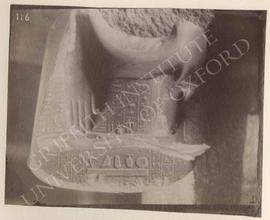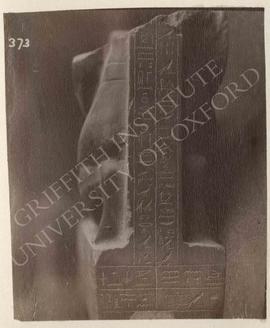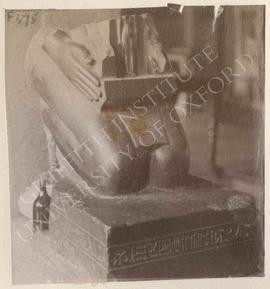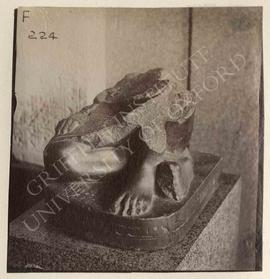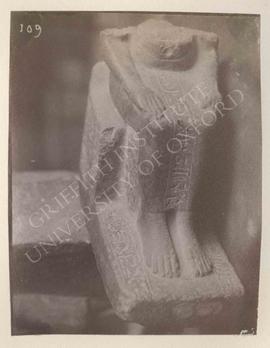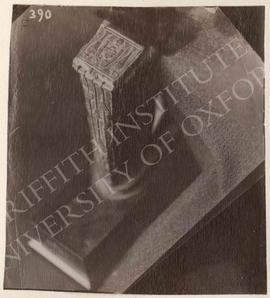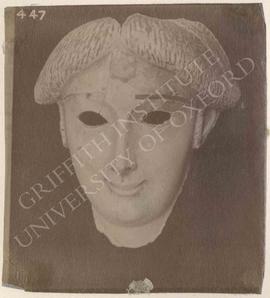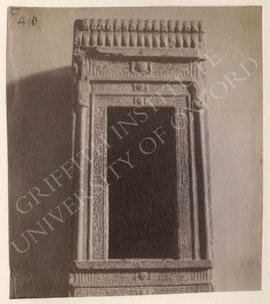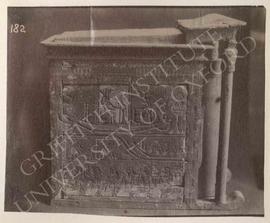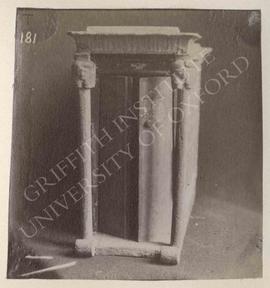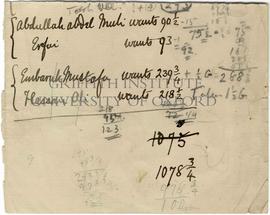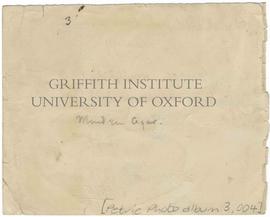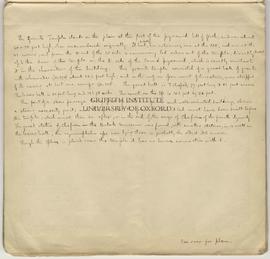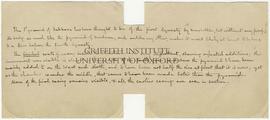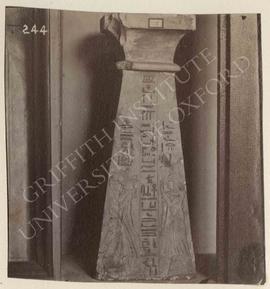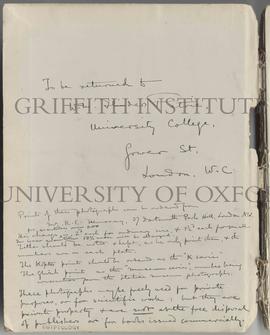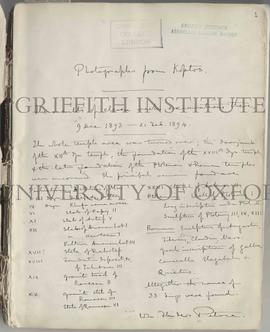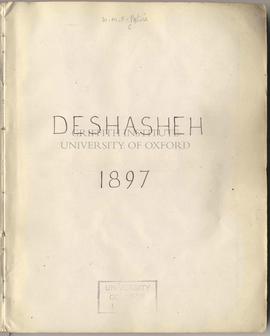- Petrie MSS 5.7.44a [loose]
- Item
- 1881-1882
Showing 1557 results
Archival description- Petrie MSS 5.7.44b [loose]
- Item
- 1881-1882
- Petrie MSS 3.1.115
- Item
- 1893
Lower part of a scribe-statue of Minnakht, diorite, temp. Tuthmosis III, probably from Qift, now in Turin, Museo Egizio, Cat. 3027.
Caption copied by Černý in Petrie MSS 3.2: 'Black granite statuette of [Mnw-nḫt] T'.
- Petrie MSS 3.1.116
- Item
- 1893
Lower part of a scribe-statue of Minnakht, diorite, temp. Tuthmosis III, probably from Qift, now in Turin, Museo Egizio, Cat. 3027.
Caption copied by Černý in Petrie MSS 3.2: 'Black granite statuette of [Mnw-nḫt] T'.
- Petrie MSS 3.1.374
- Item
- 1893
Lower part of the kneeling statue of Nekau, basalt, temp. Necho II, from Sais, now in Bologna, Museo Civico Archeologico, 1838.
Caption copied by Černý in Petrie MSS 3.2: 'Statue of [Nkȝw] B'.
Lower part of kneeling stat. of Nekau, basalt, temp. Necho.II. Bologna 1838.
- Petrie MSS 3.1.373
- Item
- 1893
Lower part of the kneeling statue of Nekau, basalt, temp. Necho II, from Sais, now in Bologna, Museo Civico Archeologico, 1838.
Caption copied by Černý in Petrie MSS 3.2: 'Statue, with shrine of Osiris, of [Ḥrw] T' (sic).
- Petrie MSS 3.1.454
- Item
- 1893
Lower part of the kneeling statue of Ramesses II with a shrine, granite, found in Rome, Iseum, now in Rome, Museo Capitolino, Inv. 27 (15).
Caption copied by Černý in Petrie MSS 3.2: 'Ramesside statue. Rome'.
- Petrie MSS 3.1.375
- Item
- 1893
Lower part of the kneeling statue of Wehebre holding a naos, basalt, temp. Amasis, found in Rome, now in Florence, Museo Archeologico, 5420.
Caption copied by Černý in Petrie MSS 3.2: 'Statue of [Wȝḥ-jb-rʿ], Cat. 1522 F'.
- Petrie MSS 3.1.224
- Item
- 1893
Lower part of the scribe-statue of Benteh-hor, basalt, temp. Necho II, from Thebes, now in Florence, Museo Archeologico, 7245.
Caption copied by Černý in Petrie MSS 3.2: 'Statue of [Ḥrw] F'.
- Petrie MSS 3.1.109
- Item
- 1893
Lower part of the seated statue of Paka, black granite, temp. Amenophis III, provenance not known, now in Turin, Museo Egizio, Cat. 3069.
Caption copied by Černý in Petrie MSS 3.2: 'Statue of [Pȝkȝ] T'.
- Petrie MSS 3.1.390
- Item
- 1893
Lower part of the statuette of a Nile-god with offerings (Roman imitation), provenance not known, now in Florence, Museo Archeologico, 543.
Caption copied by Černý in Petrie MSS 3.2: 'See 388-9'.
- Petrie MSS 3.1.352b
- Item
- 1893
Mirror in its case from the coffin of Tjesre-pert, temp. Taharqa, from Thebes, Sheikh Abd el-Qurna, Tomb of Tjesre-pert, position not known, now in Florence, Museo Archeologico.
Caption copied by Černý in Petrie MSS 3.2: 'Mirror in case from coffin 350-2 F'.
Mirrors, chisel, etc., metal, not identified, in Turin, Museo Egizio
- Petrie MSS 3.1.423
- Item
- 1893
Mirrors, chisel, etc., metal, not identified, in Turin, Museo Egizio.
Caption copied by Černý in Petrie MSS 3.2: 'Mirror, pan, chisel T'.
Mirrors, etc., not identified, now in Florence, Museo Archeologico
- Petrie MSS 3.1.314
- Item
- 1893
Mirrors, etc., not identified, now in Florence, Museo Archeologico.
Caption copied by Černý in Petrie MSS 3.2: 'Mirrors etc. F'.
Mummy-mask, pottery or plaster, not identified, now in Florence, Museo Archeologico
- Petrie MSS 3.1.447
- Item
- 1893
Mummy-mask, pottery or plaster, not identified, now in Florence, Museo Archeologico.
Caption copied by Černý in Petrie MSS 3.2: 'White plaster mask from a coffin F'.
- Petrie MSS 3.1.410
- Item
- 1893
Naos dedicated to Isis by Ptolemy VII Euergetes II and Cleopatra III, granite, from Philae, Temple of Isis, Room X, now in Florence, Museo Archeologico, 2612.
Caption copied by Černý in Petrie MSS 3.2: 'Naos, of Ptolemy Euergetes II from Philae (Cat. 1674) F'.
Naos of Kasa (TT 10), wood, from Deir el-Medina, now in Turin, Museo Egizio, Cat. 2446
- Petrie MSS 3.1.182
- Item
- 1893
Naos of Kasa (TT 10), wood, from Deir el-Medina, now in Turin, Museo Egizio, Cat. 2446.
Caption copied by Černý in Petrie MSS 3.2: 'Painted wooden shrine of [Kȝ-sȝ] Cat. 2446 T'.
Naos of Kasa (TT 10), wood, from Deir el-Medina, now in Turin, Museo Egizio, Cat. 2446
- Petrie MSS 3.1.181
- Item
- 1893
Naos of Kasa (TT 10), wood, from Deir el-Medina, now in Turin, Museo Egizio, Cat. 2446.
Caption copied by Černý in Petrie MSS 3.2: 'Painted wooden shrine of [Kȝ-sȝ] Cat. 2446 T'.
- Petrie MSS 5.5.37d [lower right]
- Item
- 1881-1882
Giza (Gîza). The Great Sphinx.
Note reads:
'The Sphinx is supposed to be of pyramid date from (1) a tablet of the time of Xufu which mentions it, and from (2) the dream of Thothmes IV which attributes it to Xafra. (3) also its surroundings at Gizeh, of any consequence, are of that period. But on the other hand the tablet was found in a temple of Petuxanu of 21st dynasty, and is clearly a later and altered copy (or an invention) as it contains figures of Osiris, Isis and Horus, Horus, Isis Seth, Pasht?, Khem, the human headed uraeus, and sacred bark, which are not found on the early monuments: beside which the mention of the sphinx in it is only an incidental topographical allusion, not essential to the tablet. The allusion by Thothmes IV is also not conclusive, and it is of doubtful critical value concerning a king who reigned 1000 or 2000 years earlier. The strongest positive argument for the late date of the sphinx is that no drawing of a sphinx in symbols, or hieroglyphs, & no statue, is known before the Hyksos; the black granite Hyksos sphinx in Bulak being the earliest I believe. Was it not then an Asiatic idea (see the Assyrian human-headed animals) imported by the Hyksos? To them seems due the notion of burying images of slaves with a body, none such being known before their epoch, and this being a form of the Asiatic custom of burying strangled slaves with a great funeral.'
- Petrie MSS 5.5.19e
- Item
- 1881-1882
Giza (Gîza). Pyramid Complex of Khafra (Khafre; Khephren). Valley Temple.
Notes opposite photographs on page 19 which read:
'The Granite Temple stands on the plain at the foot of the pyramid hill of gizeh; and was about 40 or 50 feet high, when unencumbered originally. It had probably two entrances, one at the N.E., and one at the S.E. corner; and from the N. end of the W. side a causeway led askew out of the temple, directly (No 365) up to the door of the temple on the E. side of the Second pyramid, which is exactly similar to it in the character of the building. This granite temple consisted of a great hall of granite with colonades (No 376) about 22 1/2 feet high; and on the roof an open court of limestone, now stripped of its casing all but one corner (No 368). The great hall is T shaped, 77 feet long & 86 feet across. The lesser hall is 60 feet long and 12 1/2 ft wide. The court on the top is 103 feet by 86 feet.
The fact of a skew passage being part of such a regular and well-oriented building, shews a strong necessity for it; and therefore that the place to which it led must have been built before this temple; which must then be after, or in the end of the reign of Chefren of the fourth dynasty. The great statue of Chefren in the Bulak Museum was found, with smaller statues, in a well in the lesser hall; the cynocephalus ape now lying there is probably the oldest idol known.
Thought the Sphinx is placed near this temple it has no known connection with it.
In the bottom right hand corner of the page there is also the note: 'See over for plan.'.
Notes on the Pyramid of Sakkara
- Petrie MSS 5.5.02c [notes]
- Item
- 1881-1882
Saqqara (Saqqâra). Step Pyramid of Neterikhet (Djoser).
Notes read:
'The Pyramid of Sakkara has been thought to be of the first dynasty by Mariette, but without any proof; its being so much like the pyramid of Medum, and unlike any other, makes it most likely at least to belong to a time before the fourth dynasty.
The finished coats of casing inside the structure are very important, shewing repeated additions; the innermost now visible is almost in the middle of the South face, and shews the pyramid to have been mainly added to on the West and North, and to have been not half the size at first that it is now; yet as the chamber is under the middle, that seems to have been made later than the pyramid.
None of the final casing remains visible, & all the earlier casings are seen in section.'
Notes on the pyramid of Abu Roash
- Petrie MSS 5.5.04e [verso]
- Item
- 1881-1882
Abu Rawash (Abû Rawâsh). Pyramid of Radjedef (Razedef).
Notes read:
'The pyramid of Abu Roash is perhaps before the fourth dynasty. Its builder was Ramen... [<-N5-mn-//->], probably one of the earlier unclassed Menkara kings, as Menkara of the fourth is known already at Gizeh, the third pyramid being his. the bit of cartouche I found on a scrap of a diorite statue(?) which lay among the chips of granite sarcophagus, &c, just before the doorway. That the pyramid was finished is clear by the finding of traces of sarcophagus & statue, and by the large heaps of chips of worked granite left around it, from cutting the granite casing to pieces at a later time.
The lining of the rock-hewn passage and chamber was torn out 40 or 50 years ago: the chamber, now 30x70 ft, would be narrowed by lining enough to be roofed by slanting slabs [drawing] as usual. That there was granite in part of the inside is shewn by the large heaps of chips reaching some way in front of the entrance.'
Offering-stand of Penbuy, from Deir el-Medina, now in Turin, Museo Egizio, 22026 (Cat.1559)
- Petrie MSS 3.1.244
- Item
- 1893
Offering-stand of Penbuy, from Deir el-Medina, now in Turin, Museo Egizio, 22026 (Cat.1559).
Caption copied by Černý in Petrie MSS 3.2: 'Altar? of [Pnbwjj] T'.
Ostracon with acrobat, New Kingdom, provenance not known, now in Turin, Museo Egizio, Cat. 7052
- Petrie MSS 3.1.203
- Item
- 1893
Ostracon with acrobat, New Kingdom, provenance not known, now in Turin, Museo Egizio, Cat. 7052.
Caption copied by Černý in Petrie MSS 3.2: 'Tumbler. Red outline on limestone flake. T'.
- Petrie MSS 5.4.00
- Item
- 9 December 1893-21 February 1894
-Inside front cover.
-Handwritten note by W. M. Flinders Petrie.
-'To be returned to W. M. Flinders Petrie, University College, Gower St, London. W. C.'
-'Prints of these photographs can be ordered from Mr. R.C. Murray, 37 Dartmouth Park Hill, London N.W. His charge for quantities over 200 is 2d each for ordinary size, & 1 1/2d each for small. For lesser quantities 50% more will be charged.'
-'Titles should be noted & kept, as he only prints them, & the numbers are on each plate.'
-'The Koptos prints should be ordered as the "K series". The Ghizeh prints as the "Museum series", numbers being consecutive from the Italian museum photographs.'
-'These photographs may be freely used for private purposes, or for scientific work : but they are private property & are not at the free disposal of publishers or for books issued commercially.'
- Petrie MSS 5.2.00A
- Item
- 1897
- Petrie MSS 5.4.01
- Item
- 9 December 1893-21 February 1894
-First page.
-Handwritten by W. M. Flinders Petrie.
-Qift (Koptos; Coptos).
-'Photographs from Koptos.'
-'The results of eleven weeks excavations there, 9 Dec. 1893 - 21 Feb. 1894.'
-'The whole temple area was turned over; the door jamb of the XIIth Dyn temple, the foundations of the XVIIIth Dyn. temple, & the later foundations of the Ptolemaic & Roman temples were uncovered. The principal remains found are
-Prehistoric. 3 statues of Min
-I-III Dyn Reliefs, etc, pottery.
-IV Dyn Khufu name on vase.
-VI [Dyn] Slabs of Pepy II
-XI [Dyn] Slabs of Antef V
-XII [Dyn] Slabs of Amenemhat I
-[XII Dyn] [Slabs of] " Usertesen I
-[XII Dyn] Vulture Amenemhat III
-XVII? [Dyn] Stele of Rahotep
-XVIII [Dyn] Foundation deposits, etc, of Tahutmes III
-XIX [Dyn] Granite triad of Ramessu II
-XX [Dyn] Granite stele of Ramessu III
-[XX Dyn] Stele of Ramessu VI
-XXVI [Dyn] Chapel of Aahmes II
-Ptolemaic. Wall of Ptolemy I
-[Ptolemaic.] Long inscription under Ptol. II
-[Ptolemaic.] Scultpture of Ptolemy III, IX, XIII
-Roman Sculpture of Augustus,Tiberius, Caius [= Caligula], Claudius, Nero.
-[Roman] Greek inscriptions of Galba Caracalla Elagabalus & Quietus.
-Altogether the names of 33 kings were found.
W. M. Flinders Petrie.'
- Petrie MSS 5.2.00B
- Item
- 1897
Deshasheh (Dishasha; Dishâsha).
![Loose note B [recto]](/uploads/r/null/4/4/0/4403a8ed29d2092f794a7ef925564d52f8cf455515f6864c8389336abbd6062f/Petrie_5_7_loose_note_B_recto_res600ppi_142.jpg)
![Loose note B [verso]](/uploads/r/null/7/1/1/711ba7c7ff831db951469bc875308d60365a677bd17a452408942200bbbdf4cd/Petrie_5_7_loose_note_B_verso_res600ppi_142.jpg)

